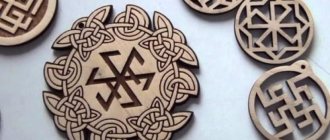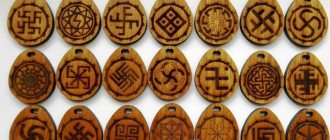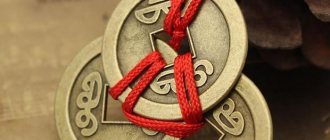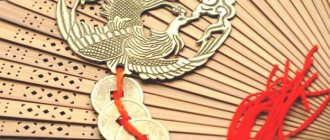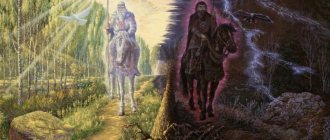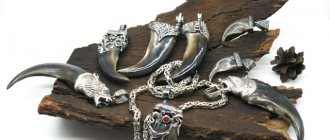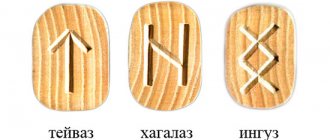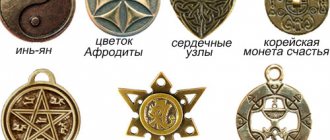If you ask any of our compatriots what amulets he knows, 99% of the audience will name crosses and icons. However, there is a much more ancient and energetically powerful symbolism, undeservedly pushed into the background by the expansion of Christianity.
This symbolism accompanied our ancestors everywhere: it was embroidered on clothing and displayed in jewelry, it was used to decorate homes and outbuildings, and it was painted on the skin during some rituals. Our ancestors lived in harmony with the forces of nature, their own tribe and the surrounding world.
Rurik. Fragment of a painting by I.E. Ozhiganova
Old Slavic symbols-amulets for men and women have a clearly defined geometric shape, which surprisingly resonates with schematic images of Galaxies, planetary systems, and the human genome. How our ancestors managed to come to such a deep understanding of the macro- and microworlds is a mystery that has not been solved to this day.
Unfortunately, many pre-Slavic symbols have been discredited. This happened during World War II with the swastika, which is an ancient Aryan symbol for the sun. Among the Slavs it was called Kolovrat and, in addition to its main solar meaning, symbolized the circulation and eternal movement of all things.
Nowadays, few people understand pre-Slavic symbolism: centuries of persecution by monotheistic religions could not have passed in vain. However, there is a return to the roots: we have finally appreciated the heritage of our ancestors and their great wisdom. This is natural: the symbols that have come down to us from hoary antiquity still work today.
The history of the origin of Russian symbols
The meaning of Slavic runes is closely intertwined with the Scandinavian Elder Futhark. These characters have a common origin, having a close connection with Germanic, Romanesque and Alpine characters. The main influence on writing in the ancient period of the Romano-Germanic peoples was the Etruscans, which affected the development of culture in the villages of the eastern tribes of the Slavs and Celts. As a result, symbols appeared that vaguely resemble runes.
Over time, the writings were modernized, developed, and under the beliefs of pagan culture acquired a sacred meaning. This contributed to the emergence of runic writing. Ancient ancestors believed that those who are fluent in runic writing are able to contact the gods and influence the development of the fate of a particular people. For this reason, the ancient Slavs treated shamans with respect and fear, because they were guides to the other world.
According to archaeological fossils, the Etruscans, Wends and Slavs performed simple rituals associated with birth, burial or any other ritual action. At the excavation site, tablets with a runic image were discovered. Initially, Slavic runes were more reminiscent of Scandinavian ones, but over time they were modernized into authentic signs.
An example is the use of the Scandinavian rune Freyra - Inguz. Signs such as Algiz or Ansuz almost instantly appeared in the runic writings of different peoples. The exception is Norwegian or Swedish writing options that were not used for ritual and magical purposes. Algiz did not change his appearance in runic writing for about 1000 years. There are even Slavic images dating back to the 12th century where this rune was drawn.
It is worth noting that the period from the 10th to the 16th centuries in the development of Rus' is an era of dual faith. For about five hundred years, Slavic paganism was gradually eradicated, since the Christian belief was forcibly implanted and many residents of Rus' did not want to change customs and traditions. Until now, in modern culture there are echoes of ancient Russian beliefs among modern people.
Agni symbol
Amulets with this symbol are among the most ancient. This image is so old that it is not even possible to find out its origin for certain. The symbol is considered Aryan-Slavic. In India, amulets with it are used everywhere, but in Rus' they have almost forgotten about it due to the forced imposition of Christian symbols and paraphernalia that took place after the Baptism of the Slavs under Prince Vladimir. By the way, the prince himself, before he accepted the Christian faith, did not part with this amulet, like many others.
Russians were warned about a 78% rise in wholesale sugar prices
Actress twin sisters Arntgolts became mothers 20 days apart
“The first pancake is lumpy, the second...”: what does the continuation of the famous saying sound like?
How is this ancient symbol useful? What does it mean? This sign is the embodiment of the sacred fire, hearths and incense burners of the altars of the gods.
The Agni amulet performs the function of mediation between man and the “light” gods.
It attracts to its owner:
- vitality and energy;
- protects his home and family;
- bestows prosperity and prosperity.
Without a doubt, this is an incredibly powerful symbol. However, it should not be used by people who are envious, greedy, prone to meanness and evil thoughts.
Meaning, description and interpretation of Slavic runes
Most Slavic runes resemble Scandinavian runes in appearance and are interpreted in a similar way. The main difference between the alphabet is different names and a reduced number of runes. The Slavs have only 18 runes, while the Scandinavians have 24.
The main interpretations of Slavic runes according to the list:
- World. This is the rune that opens the beginning of the alphabet. This sign looks like a tree, the branches of which are directed upward towards the sunlight. The symbol is identified with the life cycle, the beginning of the path and the tree of life. In fact, the sacred meaning lies in the birth of a person. The branches of the tree point upward for a reason. This is a sign of a deep divine connection, an appeal to the spiritual world. Along these branches the magical power of the gods descends into the material world. Meaning – protection from dark forces, spiritual protection.
- Chernobog is the opposite rune. This is an inverted image of the World rune. The branches of the tree point down towards the dark world. Chernobog is a symbol of chaotic forces and destruction. This is a counterbalance to the creative energy coming from the first sign. Both symbols are a dualistic image of the life picture. There is no just white or black stripe. Moments in life change, so these signs always go side by side. In the traditional understanding, Chernobog is the completion of the cycle of life, destruction, death, necessary for further rebirth.
- Alatyr is the third symbol of life, balancing good and evil, fire and water, eternity. This is one of the most mysterious and sacred runes. Alatyr looks like a straight line, with a branch down to the left. The reasons for the appearance of such an image are not known, since the sign is not logically identified with the interpretation of the symbol. In mythology, Alatyr is the center of the earth, the magic around which Chernobog and Belobog fight. The meaning of the sign is balance, maintaining strength, restoration, opening up new possibilities.
- Rainbow is the Slavic rune of the road, advancement, reunion and outside help. There is a similar sign in the Elder Futhark. For magical purposes, the Rainbow is used to attract good luck, help with travel and protect against unpleasant events on the road. Interpretation in fortune telling - the discovery of new opportunities, the pursuit of the intended goal without delay, a positive attitude in life. In mythology, the Rainbow opened a long path to the Alatyr stone.
- Need is the rune of sadness, grief and the afterlife. The meaning of the symbol is that life ends with death, remember death. In fortune telling, this is a symbol of limitation, constraint, prohibition. Need often indicates unpleasant circumstances, indecision, and the inability to change anything in life. This symbol is identified with Viy, the deity of the underworld.
- Krada is a Slavic rune of the fire element. This is a sign of vitality, inner spark, spiritual fire. In fortune telling, Krada indicates great energy potential and the desire for life. If this rune appears in a reading regarding health issues, then the answer is positive. The protagonist will quickly and forever get rid of the illness that tormented him. In an inverted position, Krada can mean an illness associated with an increase in body temperature - ARVI, influenza. In magic, it is a sign of potential, hidden abilities and spiritual purification.
- Treba is the rune of sacrifice. This is a symbol of an unshakable warrior spirit, ready to lie on his deathbed for the sake of other living ones - loved ones and relatives. In part, Treba is associated with warriors and extraordinary masculinity and sacrifice. In the magical understanding, Treba directly hints that you need to give something close in return in order to get what you want.
- Strength is another powerful and courageous sign. This Slavic rune helps to free up consciousness, get rid of prejudices and see the true face of the world. Power is associated with the Sun rune from Futhark or the god Ra, from Egyptian mythology. This is bright energy driven by good intentions and intentions. The meaning of the rune is direction to the right path, getting rid of a false life and delusions.
- Yes is a vital sign of the entire surrounding world. This is a light energy rune, indicating the life that surrounds a person. Interpretation in fortune telling - a second chance, healing from a protracted illness, forgiveness, a positive outcome of the event.
- Wind is the rune of the god of fertility and cattle Veles. This god is also considered the spirit who created magic among the Slavs. In a magical meaning, it is a sign of creativity, hidden forces, including life and magic. The wind also symbolizes the desire for the best - wealth, luck, power and strength in a positive way, without cruelty, cunning and deception.
- Bereginya is a female protective runic image, meaning fertility. Associations among the Slavs are procreation, harvest, femininity. The meaning of this Slavic rune contains the prototype of the primordial goddess, Mother of the Earth. According to mythology, the deity breathes life into the body, and when the time comes to die, he takes the spirit back. Bereginya symbolizes the full cycle of existence, including life, death and fate.
- Oud - literally translated from ancient Slavic as “limb”. In its literal sense, Oud means the male sexual organ or masculinity. Oud correlates with the deity Yarovit, who is the son of Beles. The second meaning is sexual energy, high libido, regardless of gender, including women and men. The ancient Greeks had a deity by analogy - Eros.
- Lelya is a sign of the goddess Lelya, who is identified with the water element. This is a sign of everything living, moving and flowing. This rune symbolizes the awakening of the living after hibernation with the arrival of spring, rejuvenation. In magical terms, the symbol is associated with good intuition and sacred knowledge.
- Rock is the Old Russian rune of beginning and end, of the unmanifested spirit. In magic, this sign is used to attract a third force, but if it intervenes in the situation, the end will be unpredictable. The designation is fate.
- The support is the sign of the tree of the world, which symbolizes three dimensions, including the human, natural and divine plane. Shamans use the support to communicate with the divine plane in the material world. In essence, this is a sign of a bridge, necessary for establishing a spiritual connection.
- Dazhdbog is a positive rune in terms of material wealth. It symbolizes wealth, luck, happy love, the power of family relationships, joy, and spiritual growth. Essentially, this deity symbolizes abundance, the absence of need. In terms of fortune telling, a fallen rune is interpreted as good luck in life, fortune, the emergence of prosperity, abundance in life. In any situation, this sign indicates a positive outcome for the questioner.
- Perun is the Slavic rune of the god of war, lightning, rain and thunder of the same name. This spirit protects the earthly world from the forces of evil and chaos. Perun denotes brute physical strength, weapons and will aimed at protecting a person. Raises morale and mood. Associated meanings are dragon, rod.
- The source is ice, by analogy it is identified with the Scandinavian rune Isa. When answering any question, it means stagnation, lack of development, marking time. In terms of business, this is a bad sign. We must try to solve the problem before losses and negative consequences arise.
Men's amulets
Slavic men were warriors, breadwinners, and hunters. They faced danger from different sides. Purpose of a male talisman:
- luck in battle;
- protection from enemies;
- strengthening masculinity and determination;
- saving health.
The most effective were considered amulets made by the hands of mothers and wives. Men's amulets had a laconic design. Most often they were silver and copper, in the form of bracelets and pendants. Clothes, weapons, and ammunition were also decorated with symbols.
Talismans for men have a more aggressive energy. If a woman wears them, she can adopt some masculine qualities: courage, confidence, emotional stability.
- Pendant “Arrow of Perun” RUB 3,600. BuyQuick view
- Pendant “Hatchet with triskele” RUB 4,200. BuyQuick view
- Pendant “Mammen” 5,400 rub. BuyQuick view
Ax of Perun
An amulet that gives a man determination, courage, and perseverance. Gives physical and spiritual strength, helps preserve family values. The aggressive warlike god Perun protects his owner from dangers and protects the home from enemies.
- Pendant “Axe of Perun” RUB 2,850. BuyQuick view
- Pendant “Axe of Perun” (replica). Bronze 650 rub. – 800 rub. BuyQuick view
- Pendant “Perun’s Axe” (replica) RUB 4,400. BuyQuick view
Shield of Perun
The amulet helps to cleanse oneself of foul language and bad thoughts, and gives the owner the strength to overcome life’s troubles. Wearing the Shield of Perun is taboo for women, since the symbol has powerful energy.
Source
The sign represents the goddess Zhiva, the patroness of people. The symbol concentrates spiritual energy, which a person directs to achieve his plans. The amulet is suitable for those who want to develop physically and energetically.
Amulet of Veles
Opens access to secret knowledge, helps to reveal inner potential, develops the sixth sense. The talisman will be useful to those who strive for improvement and engage in spiritual practices.
- Ring “Seal of Veles” 3,000 rub. BuyQuick view
Seal of Veles
The symbol is depicted in the form of a wolf's paw. The amulet is interpreted as freedom and independence: qualities inherent in a wolf. The wearer of the amulet will be able to realize himself professionally, obtain a leadership position, and gain authority.
- Ring “Seal of Veles” 3,000 rub. BuyQuick view
Valkyrie
The sign represents courage, honor, justice. It can be worn by men and women to strengthen character and strengthen will. The amulet will help men find a worthy life partner, and women will help them overcome adversity.
Tree of Life
Amulet for protection against diseases and problems. Has strong positive energy. The symbol personifies the divine principle and connects a person with his ancestors. The image of a tree contains a deep sacred meaning: past, present and future.
The most powerful Russian runes
You should familiarize yourself with the strong signs performed by the Aryan specialist Averyanov and Dobrynya, who optimized the Slavic runes and amulets for various needs. The directory looks like this:
- Lada Bogoroditsa - application is aimed at the emergence of conception, the revelation of feminine power. Used by couples who cannot have a child for a long time.
- Prosperity attracts money. Manufacturing is necessary if the protagonist has not had a job for a long time or has lost a successful life. Attracts prosperity.
- Bereginya becomes a faithful assistant if you need protection from evil. The sign works by transforming negative energy into positive energy. Can be used by a beginner. Suitable for dispelling negative and imposed thoughts.
- Svyatogor is a talisman that establishes connections with ancestors and spirits. Like the Mandala, where the deities reside, Svyatogor brings the material world closer to the spiritual.
- Indestructibility - the combination directs the human spirit like an arrow, developing his astral shell, allowing him to acquire sacred energy.
- Life-Giver - it should be written when spiritual training is required. This is a sign of mentoring.
- The inner creator is a sign of intuition, premonition. Improves concentration. Symbolizes the rotation of thoughts, the stream of consciousness.
Where did the tradition come from?
Women were engaged in making amulets. These were people close to the man: wife, mother, daughter, etc. If a trip to war was imminent, then several protective amulets were performed at once. They believed that in this way they protected the family breadwinner from death. If he did die, then it was believed that in the process of making talismans all the rules were not followed.
When it came to making metal amulets, women turned to artisans for help. Silver, bronze and gold were used as the basis. Only the rich could afford the latter material. It was most suitable for making solar talismans because it enhanced their energy.
In Rus', immediately after the birth of a boy, amulets were put on him. Some took off after a certain time. Others used it constantly.
Talismans that helped the father in life were inherited by his sons. Traditions associated with magical symbols are still relevant today.
Methods of activation and application
In modern mysticism, there are several options for activating and applying runes. Runic signs are usually activated with the help of natural elements, pronouncing spell words in the native language and washing them in water, burning them in a candle flame, dipping them in salt, and then in the ground.
After activation, be sure to make a sacrifice to the Slavic gods - just put bread, fruits or sweets in a deserted place in the forest and thank them mentally. It is recommended to give the offering on a sunny and bright day. If it is cloudy outside, the action is postponed.
Signs are applied to amulets made of wood, leather, stone or clay. Recommended colors are black, blue, red or green. You can write the usual inscription on a piece of paper if you need a short-term effect or acceleration of action. Slavic runes are reversed to produce the opposite effect.
Classification of amulets
Slavic amulets are divided into types according to their purpose:
- for men;
- for women;
- universal.
Each sign depicted on a magical object has a separate designation associated with natural elements. The power of the universe lies in graphic lines. The amulet acts as a link between the material world and higher powers. In ancient Slavic mythology, representatives of different sexes had separate patrons. Amulets were selected not only by month of birth, but also by gender.
In the old days, the following materials were used to make amulets:
- metal;
- wood;
- animal bones.
Nowadays, the best solution would be to choose a silver amulet. This decoration will last longer and will fit harmoniously into your wardrobe. Silver itself has protective properties. Magic symbols applied to it increase the strength of the metal.
How to use ancient runes
In the course of studying runic magic, it becomes known that runes are used in the form of formulas, in combination with other signs. Runes are combined depending on their decoding and compatibility. User reviews indicate that Slavic runes are also good for fortune telling.
The most popular is the creation of runic ligatures and staves - intertwined signs used to attract good luck and material wealth, love and affection from friends, or to protect against negative energy.
Horse symbol
This sign belongs to the god Khors, brother of Veles. In ancient times, Khors patronized merchants and all those who were engaged in trade, at least periodically.
How is such a talisman useful? An ancient symbol will attract:
- buyers or customers;
- will facilitate the sale of goods at the best prices and in the shortest possible time;
- will not allow you to conclude a “bad” deal.
However, the amulet cannot be worn by those who engage in dishonest trade - sell damaged goods, shortchange or overcharge customers, or deceive customers.
Runic combinations
Drawing up combinations was highly valued in ancient times, because in this way several deities were involved in solving a problem.
History has preserved the following descriptions of runic combinations:
| Problem | Rune combination | Effect of runes |
| Attracting wealth | Dazhdbog - Strength - Support - Lelya |
|
| Finding and keeping love | Yes - Oud - Strength |
|
| Shield from the evil eye and damage | Dazhdbog - Treba - Dazhdbog |
|
| Protection on the road | World - Rainbow - Peace |
|
